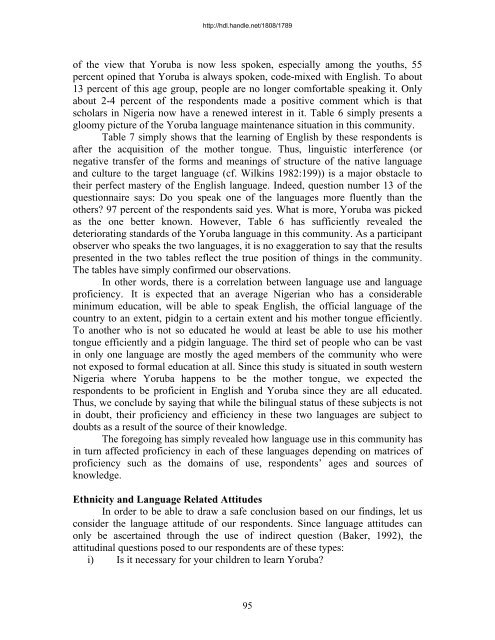LANGUAGE CONTACT AND LANGUAGE ... - KU ScholarWorks
LANGUAGE CONTACT AND LANGUAGE ... - KU ScholarWorks
LANGUAGE CONTACT AND LANGUAGE ... - KU ScholarWorks
You also want an ePaper? Increase the reach of your titles
YUMPU automatically turns print PDFs into web optimized ePapers that Google loves.
http://hdl.handle.net/1808/1789<br />
of the view that Yoruba is now less spoken, especially among the youths, 55<br />
percent opined that Yoruba is always spoken, code-mixed with English. To about<br />
13 percent of this age group, people are no longer comfortable speaking it. Only<br />
about 2-4 percent of the respondents made a positive comment which is that<br />
scholars in Nigeria now have a renewed interest in it. Table 6 simply presents a<br />
gloomy picture of the Yoruba language maintenance situation in this community.<br />
Table 7 simply shows that the learning of English by these respondents is<br />
after the acquisition of the mother tongue. Thus, linguistic interference (or<br />
negative transfer of the forms and meanings of structure of the native language<br />
and culture to the target language (cf. Wilkins 1982:199)) is a major obstacle to<br />
their perfect mastery of the English language. Indeed, question number 13 of the<br />
questionnaire says: Do you speak one of the languages more fluently than the<br />
others? 97 percent of the respondents said yes. What is more, Yoruba was picked<br />
as the one better known. However, Table 6 has sufficiently revealed the<br />
deteriorating standards of the Yoruba language in this community. As a participant<br />
observer who speaks the two languages, it is no exaggeration to say that the results<br />
presented in the two tables reflect the true position of things in the community.<br />
The tables have simply confirmed our observations.<br />
In other words, there is a correlation between language use and language<br />
proficiency. It is expected that an average Nigerian who has a considerable<br />
minimum education, will be able to speak English, the official language of the<br />
country to an extent, pidgin to a certain extent and his mother tongue efficiently.<br />
To another who is not so educated he would at least be able to use his mother<br />
tongue efficiently and a pidgin language. The third set of people who can be vast<br />
in only one language are mostly the aged members of the community who were<br />
not exposed to formal education at all. Since this study is situated in south western<br />
Nigeria where Yoruba happens to be the mother tongue, we expected the<br />
respondents to be proficient in English and Yoruba since they are all educated.<br />
Thus, we conclude by saying that while the bilingual status of these subjects is not<br />
in doubt, their proficiency and efficiency in these two languages are subject to<br />
doubts as a result of the source of their knowledge.<br />
The foregoing has simply revealed how language use in this community has<br />
in turn affected proficiency in each of these languages depending on matrices of<br />
proficiency such as the domains of use, respondents’ ages and sources of<br />
knowledge.<br />
Ethnicity and Language Related Attitudes<br />
In order to be able to draw a safe conclusion based on our findings, let us<br />
consider the language attitude of our respondents. Since language attitudes can<br />
only be ascertained through the use of indirect question (Baker, 1992), the<br />
attitudinal questions posed to our respondents are of these types:<br />
i) Is it necessary for your children to learn Yoruba?<br />
95
















